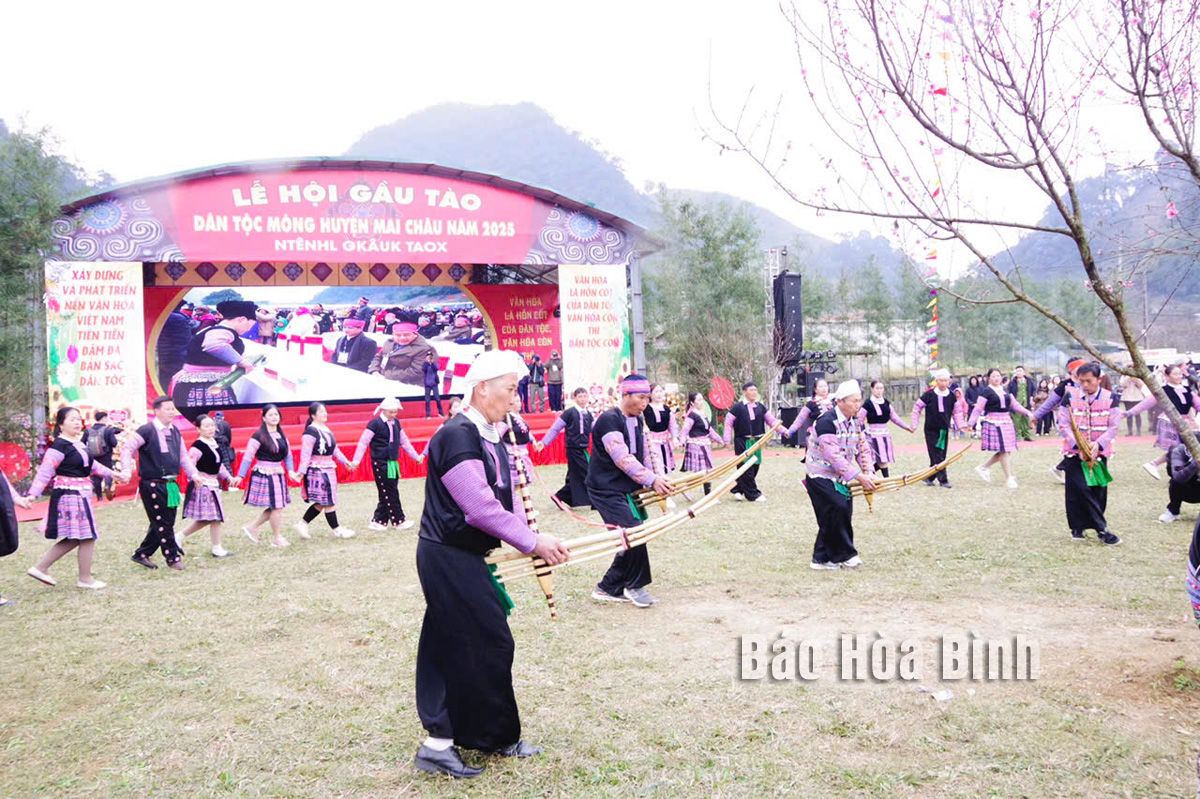
Gau Tao Festival, one of the most important traditional festivals of the Mong ethnic minority group in Mai Chau district was held at the Pa Co stadium in Pa Co commune on January 11.
Attending the festival were members of the Standing Board of the Hoa Binh Party Committee: Nguyen Van Toan, Permanent Vice Chairman of the provincial People's Committee; Vo Ngoc Kien, head of the provincial Party Committee’s Information and Education Board; and Colonel Do Thanh Binh, Director of the provincial Public Security Department. The event also saw Ding Cong Su, Vice Chairman of the provincial People's Committee; Dang Bich Ngoc, deputy head of the provincial delegation of National Assembly deputies; Colonel Trinh Duc Thiem, Commander of the provincial Military Command, among others.
The "neu” tree-planting and offering ceremony is the most important ritual of the Mong ethnic minority group’s Gau Tao Festival in the two communes of Hang Kia and Pa Co, Mai Chau district.
The Gau Tao Festival is a traditional folk festival, a long-standing cultural ritual and spiritual activity of the Mong people. In the two communes of Hang Kia and Pa Co, the festival has been revived since 2017. This year, the festival consisted of two main parts. The first part, the ceremonial activities, featured the key ritual of erecting the "neu” (bamboo pole) – a sacred symbol connecting heaven and earth. This part also included spiritual and cultural activities where offerings such as chickens, wine, rice, and paper were made to the "neu.” The ceremony leader lit incense, burned ghost money, and walked around the "neu” pole three times in a counter clockwise direction, then repeated the process while singing the "Tinh chay” song to announce to the deities that the "neu” had been erected, and to pray for a good year with favourable weather, bountiful harvests, and happiness and health for everyone.
As the festival drum sounds, the Mong people join in a traditional circle dance around the "neu” pole.
The festival includes a variety of exciting activities such as making sticky rice cakes, throwing "con” balls, tug-of-war, and more.
The festival also featured cultural performances showcasing the ethnic group’s identity, presented by young Mong men and women; tours of food, agricultural products, and unique items from the Mong community; traditional games like "pao” ball throwing, "tu lu” hitting, stilt walking, tug-of-war, and khen dance performances; sticky rice cake making contests; and traditional costume competitions.
Through the organisation of the Gau Tao Festival, the event contributes to the preservation, promotion, and honouring of the Mong ethnic group’s cultural heritage. Additionally, it enhances the introduction and promotion of the history, culture, and tourism potential of the two communes of Pa Co and Hang Kia to visitors. The festival fulfils the spiritual and cultural desires of the people in these two communes, fostering a healthy cultural environment and creating a joyful and optimistic atmosphere to welcome the Spring of the Year of the Snake. The Gau Tao Festival is closely linked to the worldview of the Mong people in the Northwest, reflecting their wishes for health, prosperity, favourable weather, abundant harvests, and growth.
With an increasingly vibrant and widespread emulation movement aimed at building cultured residential areas and cultured families, Yen Thuy District has been making steady progress toward improving both the material and spiritual well-being of its people, while fostering a civilized, prosperous, beautiful, and progressive community.
Once lacking recreational spaces and community facilities, Residential Group 2 in Quynh Lam Ward (Hoa Binh City) has recently received attention for the construction of a new, spacious, and fully equipped cultural house. The project followed the model of state support combined with public contributions in both labor and funding.
The "All people unite to build cultural life" movement, which has been effectively integrated with Kim Boi district’s socio-economic development goals, is fostering a lively spirit of emulation across local residential areas, hamlets, villages, public agencies, and enterprises. In addition, through the initiative, traditional cultural values are being preserved and promoted, while community solidarity and mutual support in poverty reduction and economic development are being strengthened.
A working delegation of the Hoa Binh provincial People’s Committee led by its Permanent Vice Chairman Nguyen Van Toan on June 11 inspected the progress of a project to build the Mo Muong Cultural Heritage Conservation Space linked to tourism services in Hop Phong commune, Cao Phong district.
Born and growing in the heroic land of Muong Dong, Dinh Thi Kieu Dung, a resident in Bo town of Kim Boi district, in her childhood was nurtured by the sweet lullabies of her grandmother and mother. These melodies deeply imprinted on her soul, becoming an inseparable part of her love for her ethnic group's culture. For over 20 years, this love for her hometown has driven Dung to research, collect, and pass down the cultural values of the Muong people to future generations.
In the final days of May, the Ethnic Art Troupe of Hoa Binh Province organized performances to serve the people in remote, mountainous, and particularly disadvantaged areas within the province. These were not just ordinary artistic shows, but they were the meaningful journeys aimed at spreading cultural values, enhancing the spiritual life of the people and contributing to the preservation of ethnic minority cultural identities.



